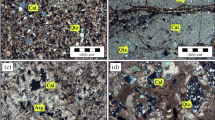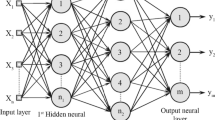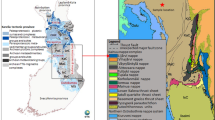Abstract
In this research, some predictive models were constructed for estimating the slake durability index of sedimentary rocks. Sandstone, limestone, travertine and conglomerate were collected as studied rocks, and comprehensive laboratory investigations such as mineralogical study and geotechnical properties including dry unit weight, porosity, Schmidt rebound hardness, P-wave velocity, uniaxial compressive strength and slake durability index were determined based on standard procedures. Results of mineralogy studies and XRD analysis showed studied rock samples are dominantly composed of quartz and calcite with different textures. The durability test, up to three cycles, was performed in fluids with different pH conditions. Based on the results, the slake durability index is affected by the pH of the test fluids, and in initial cycles, the decreasing rate of slake durability index is higher than the end cycles. Also, in most of the samples, a constant pattern exists between the slake durability index and pH of the testing solutions so that the weight loss increases with decreasing pH from 7 to 4. Soft computing techniques including multiple regression analysis (MRA), artificial neural network (ANN) and adaptive neuro-fuzzy inference system (ANFIS) were developed for estimating SDI for pH = 7 and 4 conditions. Experimental equations were obtained by MRA with correlation coefficients from 0.74 to 0.85 that show porosity, Schmidt hardness, P-wave velocity and UCS are the good parameters for estimating the SDI2 of rocks. In order to evaluate the performance of predictive models, some statistical coefficients, including R, RMSE, VAF, MAPE and PI were also calculated. ANFIS models have the best coefficients, and the results demonstrate that the ANN models are efficient when compared to MRA. Therefore, all methods obtained acceptable results, but the ANN and ANFIS are more reliable methods for estimating the SDI of rocks.













Similar content being viewed by others
Abbreviations
- SS:
-
Sandstone sample
- LS:
-
Limestone sample
- TS:
-
Travertine sample
- CS:
-
Conglomerate sample
- γ dry :
-
Dry unit weight (g/cm3)
- n :
-
Porosity (%)
- H S :
-
Schmidt rebound hardness
- V P :
-
Primary wave velocity (m/s)
- UCS:
-
Uniaxial compressive strength (MPa)
- SDI:
-
Slake-durability index (%)
- XRD:
-
X-ray diffraction
- MRA:
-
Multiple regression analysis
- ANN:
-
Artificial neural network
- ANFIS:
-
Adaptive neuro-fuzzy inference system
- R :
-
Correlation coefficient
- R 2 :
-
Coefficient of determination
- RMSE:
-
Root mean square error
- VAF:
-
Coefficient values account for
- MAPE:
-
Mean absolute percentage error
- PI:
-
Performance index
References
Abdullah GMS, El al AA, Radwan AE, Qadri T, Aly N (2022) The influence of carbonate texture and rock composition on durability cycles and geomechanical aspects of carbonate rocks. Acta Geotech. https://doi.org/10.1007/s11440-022-01561-1
Admassu Y, Hamdan H, Gautam T (2016) Multivariate statistical approach to re-evaluate the slake durability index test (ASTM 4644–08). Eng Geol 209:12–20
Afolagboye LO, Owoyemi OO, Akinola OO (2022) Effect of pH condition and different solution on the slake durability of granitic rocks. Geotech Geol Eng. https://doi.org/10.1007/s10706-022-02312-5
Ahmad M, Ansari MK, Singh R, Sharma LK, Singh TN (2017) Assessment of durability and weathering state of some igneous and metamorphic rocks using micropetrographic index and rock durability indicators: a case study. Geotech Geol Eng 35:827–842
Ahmed I, Basharat M, Sousa L, Mughal MS (2021) Evaluation of building and dimension stone using physico-mechanical and petrographic properties: a case study from the Kohistan and Ladakh batholith, Northern Pakistan. Environ Earth Sci 80. https://doi.org/10.1007/s12665-021-10007-y
Aladejare AE, Alofe ED, Onifade M, Lawal AI, Ozoji TM, Zhang Z (2021) Empirical estimation of uniaxial compressive strength of rock: database of simple, multiple, and artificial intelligence-based regressions. Geotech Geol Eng 39:4427–4455
Ankara H, Kandemir SY, Cicek C (2015) Compression of slake durability index (SDI) values of sphere and rounded marl samples. Procedia Earth Planet Sci 15:93–98
Arman H (2021) Correlation of uniaxial compressive strength with indirect tensile strength (Brazilian) and 2nd cycle of slake durability index for evaporitic rocks. Geotech Geol Eng 39:1583–1590
Arman H, Hussein S, Abouhaligah HEY, Osman M, Baloch MA, Hag DBA, Algaishi HAA (2019) Predicting weathering characteristics of carbonate rocks under different geo-environmental conditions. IOP Conf Ser: Earth Environ Sci 362:012016. https://doi.org/10.1088/1755-1315/362/1/012016
ASTM (1990) Standard test method for slake durability of shales and similar weak rocks (D4644). Annual Book of ASTM Standards, vol. 4.08. ASTM, Philadelphia
ASTM (1995) Standard test method for unconfined compressive strength of intact rock core specimens. ASTM standards on disc 04.08; Designation D2938
ASTM (1996) Standard test method for laboratory determination of pulse velocities and ultrasonic elastic constants of rock. Designation: D2845–D2895
ASTM (2001) Standard test method for determination of rock hardness by rebound hammer method. D5873 ASTM Philadelphia Pa
ASTM (2009) Standard guide for petrographic examination of dimension Stone (C1721). Book Standards, Vol 04.07
Bishop C (1995) Neural networks for pattern recognition. Oxford Press, New York
Cargill JS, Shakoor A (1990) Evaluation of empirical methods for measuring the uniaxial compressive strength of rock. Int J Rock Mech Min Sci 27:495–503
Ceryan N (2021) Prediction of Young’s modulus of weathered igneous rocks using GRNN, RVM, and MPMR models with a new index. J Mt Sci 18:233–251
Cetin H, Laman M, Ertunc A (2000) Settlement and slaking problems in the world’s fourth largest rock-fill dam, the Ataturk Dam in Turkey. Eng Geol 56:225–242
Dhakal G, Yoneda T, Kato M, Kaneko K (2002) Slake durability and mineralogical properties of some pyroclastic and sedimentary rocks. Eng Geol 65:31–45
Diamantis K, Fereidooni D, Khajevand R, Migiros G (2021) Effect of textural characteristics on engineering properties of some sedimentary rocks. J Cent South Univ 28:926–938
Dunham RJ (1962) Classification of carbonate rocks according to depositional texture. Classification of carbonate rocks, WE Ham. AAPG Mem 1:108–121
El Aal AA, Kahraman S (2017a) Estimation of durability aspects of Al Masjid Al-Haram marble, Makkah city, Saudi Arabia. Geotech Geol Eng 35:2763–2779
El Aal AA, Kahraman S (2017b) Indirect methods to predict the abrasion resistance and slake durability of marbles. J Molec Eng Mat 5(3):1–11
Fereidooni D, Khajevand R (2018) Correlations between slake-durability index and engineering properties of some travertine samples under wetting-drying cycles. Geotech Geol Eng 36:1071–1089
Fereidooni D, Khajevand R (2019) Utilization of the accelerated weathering test method for evaluating the durability of sedimentary rocks. Bull Eng Geol Environ 78:2697–2716
Folk RL (1959) Practical petrographic classification of limestones. Am Assoc Petrol Geol Bull 43:1–38
Franklin JA, Chandra A (1972) The slake durability test. Int J Rock Mech Min Sci 9(1):325–341
Gamble JC (1971) Durability–plasticity classification of shales and other argillaceous rocks. Ph.D. Thesis, University of Illinois, Urabana
Gautam TP, Shakoor A (2016) Comparing the slaking of clay-bearing rocks under laboratory conditions to slaking under natural climatic conditions. Rock Mech Rock Eng 49:19–31
Ghobadi MH, Kapelehe M (2017) The influence of pH of water and chemical composition on the durability of different rocks from Qom formation, East and Northeast of Hamedan, Iran. J Eng Geol 10:3699–3718
Ghobadi MH, Momeni AA (2011) Assessment of granitic rocks degradability susceptive to acid solutions in urban area. Environ Earth Sci 65:753–760
Ghobadi MH, Mousavi S (2014) The effect of pH and salty solutions on durability of sandstones of the Aghajari Formation in Khouzestan province, southwest of Iran. Arab J Geosci 7:641–653
Goodman RE (1989) Introduction to rock mechanics, 2nd edn. John Wiley & Sons Publication, New York
Gokceoglu C, Ulusay R, Sonmez H (2000) Factors affecting the durability of selected weak and clay-bearing rocks from Turkey, with particular emphasis on the influence of the number of drying and wetting cycles. Eng Geol 57:215–237
Gratchev I, Pathiranagei SV, Kim DH (2019) Strength properties of fresh and weathered rocks subjected to wetting-drying cycles. Geomech Geophys Geo-Energy Geo-Resour 5:211–221
GSI (Geological Society of Iran) (1977) Geological quadrangle map of Iran, No. 6862, Scale 1:100000, Printed by Offset Press Inc. Tehran
Gupta V, Ahmed I (2007) The effect of pH of water and mineralogical properties on the slake durability (degradability) of different rocks from the Lesser Himalaya, India. Eng Geol l 95:79–87
Gurney K (2009) An introduction to neural networks. UCL Press, New York
Heidari M, Mohseni H, Jalali SH (2018) Prediction of uniaxial compressive strength of some sedimentary rocks by fuzzy and regression models. Geotech Geol Eng 36:401–412
Hemeda S, Pitilakis K (2010) Serapeum temple and the ancient annex daughter library in Alexandria, Egypt: geotechnical–geophysical investigations and stability analysis under static and seismic conditions. Eng Geol 113:33–43
IAEG (1979) Classification of rocks and soils for engineering geological map**, Report by the IAEG Commission on Engineering Geological Map**. Bulletin of IAEG 24:235–274
IBM Corp. Released 2019 (2019) IBM SPSS Statistics for Windows, version 24.0. Armonk, NY: IBM Corp
ISRM (1979) Suggested method for determination of the slake durability index. Int J Rock Mech Min Sci Geomech Abstr 16:154–156
ISRM (1981) Suggested methods for determining hardness and abrasiveness of rocks, Part 3. Commission on standardization of laboratory and field tests 101–112
ISRM (2007) The blue book: the complete ISRM suggested methods for rock characterization, testing and monitoring, 1974–2006, compilation arranged by the ISRM Turkish National Group, Ankara, Turkey, R. Ulusay and J. A. Hudson, Eds., Kazan Offset Press, Ankara
Jain AK, Jianchang M, Mohiuddin KM (1996) Artificial neural networks: a tutorial. Computer 29(3):1–44
Jang JSR (1993) ANFIS: adaptive network-based fuzzy inference systems. IEEE Trans Sys Man Cybern 23:665–685
Jensen LR, Friis H, Fundal E, Moller P, Jespersen M (2010) Analysis of limestone micromechanical properties by optical microscopy. Eng Geol 110(3):43–50
Johnson RB, DeGraff JV (1988) Principles of engineering geology. Wiley, New York, p 497
Kahraman S, Fener M, Gunaydin O (2017) Estimating the uniaxial compressive strength of pyroclastic rocks from the slake durability index. Bull Eng Geol Environ 76:1107–1115
Kaunda R (2014) New artificial neural networks for true triaxial stress state analysis and demonstration of intermediate principal stress effects on intact rock strength. J Rock Mech Geotech Eng 6:338–347
Kayabali K, Beyaz T, Kolay E (2006) The effect of the pH of the testing liquid on the slake durability of gypsum. Bull Eng Geol Environ 65:65–71
Khajevand R, Fereidooni D (2019) Utilization of the point load and block punch strengths to predict the mechanical properties of several rock samples using regression analysis methods. Innov Infra Solu 4. https://doi.org/10.1007/s41062-019-0201-8
Khanlari GR, Heidari M, Noori M, Momeni A (2016) The effect of petrographic characteristics on engineering properties of conglomerates from famenin region, northeast of Hamedan, Iran. Rock Mech Rock Eng 49(7):2609–2621
Kolay E, Kayabali K, Tasdemir Y (2010) Modeling the slake durability index using regression analysis, artificial neural networks and adaptive neuro-fuzzy methods. Bull Eng Geol Environ 69:275–286
Koncagul EC, Santi PM (1999) Predicting the unconfined compressive strength of the Breathitt shale using slake durability, shore hardness and rock structural properties. Int J Rock Mech Min Sci 36:39–153
Koralegedara NH, Maynard JB (2017) Chemical, mineralogical and textural properties of the Kope Formation mudstones: how they affect its durability. Eng Geol 228:312–322
Kumar BR, Vardhan H, Govindaraj M, Vijay GS (2013) Regression analysis and ANN models to predict rock properties from sound levels produced during drilling. Int J Rock Mech Min Sci 58:61–72
Liu X, Song Y, **a Z, Chen R (2020) Assessing the slake durability of red stratum sandstone in different solution environments by a novel dual rotation test. Eng Geol 267. https://doi.org/10.1016/j.enggeo.2020.105503
MATLAB and Statistical Toolbox Released 2020b the MathWorks (2020), Inc., Natick, Massachusetts, United States
Meng J, Pan J (2007) Correlation between petrographic characteristics and failure duration in clastic rocks. Eng Geol 89:258–265
Mishra DA, Srigyan M, Basu A, Rokade PJ (2015) Soft computing methods for estimating the uniaxial compressive strength of intact rock from index tests. Int J Rock Mech Min Sci 80:418–424
Momeni A, Hashemi SS, Khanlari GR, Heidari M (2017) The effect of weathering on durability and deformability properties of granitoid rocks. Bull Eng Geol Environ 76(3):1037–1049
Monticelli JP, Ribeiro R, Futai M (2020) Relationship between durability index and uniaxial compressive strength of a gneissic rock at different weathering grades. Bull Eng Geol Environ 79:1381–1397
Moradian ZA, Ghazvinian AH, Ahmadi M, Behnia M (2010) Predicting slake durability index of soft sandstone using indirect tests. Int J Rock Mech Min Sci 47:666–671
Nielsen RH (1998) Neurocomputing: picking the human brain. IEEE Spectr 25:36–41
Rahimi MR, Mohammadi SD, Beydokhti AT (2020) Effects of mineral composition and texture on durability of sulfate rocks in Gachsaran Formation, Iran. Geotech Geol Eng 38:2619–2637
Selen L, Panthi KK, Vistnes G (2020) An analysis on the slaking and disintegration extent of weak rock mass of the water tunnels for hydropower project using modified slake durability test. Bull Eng Geol Environ 79:1919–1937
Sharma PK, Singh TN (2008) A correlation between P-wave velocity, impact strength index, slake durability index and uniaxial compressive strength. Bull Eng Geol Environ 67:17–22
Singh T, Sharma P, Khandelwal M (2007) Effect of pH on the physico-mechanical properties of marble. Bull Eng Geol Environ 66(1):81–87
Singh TN, Verma AK, Singh V, Sahu A (2005) Slake durability study of shaly rock and its predictions. Environ Geol 47:246–253
Sousa L, Menningen J, Lόpez-doncel R, Siegesmund S (2021) Petrophysical properties of limestone: influence on behaviour under different environmental conditions and applications. Environ Earth Sci 80. https://doi.org/10.1007/s12665-021-10064-3
Sousa L, Siegesmund S, Wedekind W (2018) Salt weathering in granitoids: an overview on the controlling factors. Environ Earth Sci 77. https://doi.org/10.1007/s12665-018-7669-y
Sousa LMO (2014) Petrophysical properties and durability of granites employed as building stone: a comprehensive evaluation. Bull Eng Geol Environ 73:569–588
Suparta W, Alhasa KM (2016) Modeling of precipitable water vapor using an adaptive neuro-fuzzy inference system in the absence of the GPS network. J App Meteo Climat 55(10):2283–2300
Takagi T, Sugeno M (1985) Fuzzy identification of systems and its application to modeling and control. IEEE Trans Syst Man Cybern 15(1):116–132
Tang H, Tan CK, Yi Z (2007) Neural networks: computational models and applications. Stud Com Intell 53. Springer, Berlin
Tang ZC, Zhang QZ, Zhang Y (2021) Cyclic drying-wetting effect on shear behaviors of red sandstone fracture. Rock Mech Rock Eng 54:2595–2613
Tasdemir Y, Kolay E, Kayabali K (2013) Comparison of three artificial neural network approaches for estimating of slake durability index. Environ Earth Sci 68:23–31
Wang T, Zhang H, Gamage RP, Zhao W, Ge J, Li Y (2020) The evaluation criteria for rock brittleness based on double-body analysis under uniaxial compression. Geomech Geophys Geo-Energ Geo-Resour 6:49. https://doi.org/10.1007/s40948-020-00165-x
Yagiz S (2011) Correlation between slake durability and rock properties for some carbonate rocks. Bull Eng Geol Environ 70:377–383
Yagiz S (2018) The effect of pH of the testing liquid on the degradability of carbonate rocks. Geotech Geol Eng 36:2351–2363
Yang Y, Zhang T (2022) Effects of water intrusion on thermal conductivity and durability of carbonaceous rocks. Soils Found 62. https://doi.org/10.1016/j.sandf.2021.101102
Yavuz AB, Kaputoglu SA, Çolak M, Tanyu BF (2017) Durability assessments of rare green andesites widely used as building stones in Buca (Izmir), Turkey. Environ Earth Sci 76:211–216
Zadeh LA (1965) Fuzzy sets. Information Control 8(3):338–353
Zhu J, Deng H (2019) Durability classification of red beds rocks in central Yunnan based on particle size distribution and slaking procedure. J Mt Sci 16(3):714–724
Acknowledgements
The author likes to express his thanks to Mr. P. Khajevand for the English editing.
Author information
Authors and Affiliations
Corresponding author
Ethics declarations
Ethical approval
This article does not contain any studies with human participants.
Conflict of interest
The author declares no competing interests.
Additional information
Responsible Editor: Zeynal Abiddin Erguler
Highlights
• This study aims to evaluate the SDI of rocks in different pH conditions, including 7, 5.5 and 4, and assess the effect of petrography, physical and mechanical properties.
• Mineralogy and texture of the rocks were studied by thin section and XRD analysis; also, physical and mechanical properties including γdry, n, VP, HS and UCS were determined.
• The results indicated that the decreasing rate of SDI in the initial cycles is higher than the end cycles, and weight loss increases with decreasing the pH from 7 to 4.
• Proposed some experimental equations for estimating the SDI by multiple regression analysis for pH = 7 and 4 with correlation coefficients in the range of 0.74 to 0.85.
• Performance of MRA, ANN and ANFIS models was assessed by some statistical coefficients, including R, RMSE, VAF, MAPE and PI.
• The results indicated that the ANFIS models have the best coefficients and the ANN models are efficient when compared to MRA for estimating the SDI of the rocks.
Rights and permissions
Springer Nature or its licensor (e.g. a society or other partner) holds exclusive rights to this article under a publishing agreement with the author(s) or other rightsholder(s); author self-archiving of the accepted manuscript version of this article is solely governed by the terms of such publishing agreement and applicable law.
About this article
Cite this article
Khajevand, R. Soft computing approaches for evaluating the slake durability index of rocks. Arab J Geosci 15, 1698 (2022). https://doi.org/10.1007/s12517-022-10997-4
Received:
Accepted:
Published:
DOI: https://doi.org/10.1007/s12517-022-10997-4




